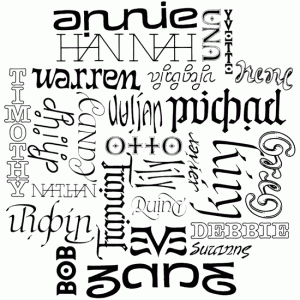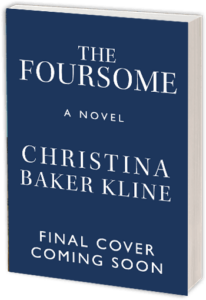On Sunday — June 12 — I’ll be on a panel called “Going Beyond ‘Tom, Dick and Mary’: Naming and Giving Your Characters Dimension” at Books NJ: A Celebration of Books and the Readers who Love Them, 1-5 p.m. at the Paramus Public Library. (Stop by and say hello!) Consequently I’ve been thinking a lot about character names this week.
So has novelist and playwright Joanne Lessner, author of Pandora’s Bottle and Critical Mass, who wonders whether she names her characters….or they name themselves:
In my alternate life (the one where I’m a jet-setting opera singer based in London), I have a clutch of children with fabulous names. The girls are called Tessa, Lily, Francesca and Imogen, and the boys are Sebastian, Phineas, Jasper and Colin. In my actual life, I’m a New York-based writer and performer with two kids who got my first round draft picks: Julian and Phoebe. But as a writer, surely I can pepper my work with those other glorious, un-exercised gems, right?
Well, not exactly.
 J.K. Rowling has famously said that Harry Potter just strolled into her head, fully formed. I understand what she means. My characters have a habit of knocking on my mental door wearing nametags. Even names that carry hints of significance are often a chicken and egg situation. For example, the hero of my novel, Pandora’s Bottle, is named Sy Hampton. I don’t recall consciously choosing his name, but one reader asked if it was meant to illustrate a “sigh” of disappointment (he’s having a mid-life crisis.) Another suggested that “Hampton” indicates a yearning for the finer things in life epitomized by those exclusive Long Island enclaves. Those are certainly reasonable assumptions, but I can’t say honestly whether Sy grew more melancholy and striving because of his name, or if, when I named him, my subconscious instinctively know where he was heading. However, I do know that when my editor floated the possibility of changing his name – feeling that Sy suggested someone of a slightly older generation – I just couldn’t.
J.K. Rowling has famously said that Harry Potter just strolled into her head, fully formed. I understand what she means. My characters have a habit of knocking on my mental door wearing nametags. Even names that carry hints of significance are often a chicken and egg situation. For example, the hero of my novel, Pandora’s Bottle, is named Sy Hampton. I don’t recall consciously choosing his name, but one reader asked if it was meant to illustrate a “sigh” of disappointment (he’s having a mid-life crisis.) Another suggested that “Hampton” indicates a yearning for the finer things in life epitomized by those exclusive Long Island enclaves. Those are certainly reasonable assumptions, but I can’t say honestly whether Sy grew more melancholy and striving because of his name, or if, when I named him, my subconscious instinctively know where he was heading. However, I do know that when my editor floated the possibility of changing his name – feeling that Sy suggested someone of a slightly older generation – I just couldn’t.
The anti-heroine of a novel I’m working on now is named Katelyn. I must confess, I’ve never been a fan of that name or its multiple spellings, so imagine my surprise when that’s what my fingers typed. Her last name is Marx, which I also don’t recall selecting, but have since recognized has political overtones in line with Katelyn’s schemes. The success of her plans will hinge on her ability to remain chameleon-like and forgettable. What better way to illustrate that quality than with a name with multiple, hard-to-keep-track-of spellings? Except that, again, I gave it no thought whatsoever. Katelyn Marx just showed up for work the day I started writing and politely introduced herself.
Still, it doesn’t always work that way. Minor characters, in particular, can be more reticent, and as they blink patiently at me in the doorway, I try to let my mind free associate until something clicks. Even so, these characters often don’t live and breathe in quite the same way as the ones who are instinctive. But giving serious thought to a name is not necessarily a bad thing, and when you hit it right, you know. As one writer friend told me recently, a simple change from Lily to Billie made her character come alive.
One situation that does require special care is naming for the stage, where the sound is more important than the way it looks on the page. In my play, Critical Mass, a character named Stefano Donato kept my cast’s tongues twisted. It looks neat and symmetrical in print, but the actors had to remind themselves where the accents were every time they said it. Lesson learned.
In a musical, names that rhyme are a boon.
I’m currently adapting Wilkie Collins’s gothic novella The Haunted Hotel. The heroine’s name is Agnes – not much joy there. But make her Alice, and suddenly we’ve got malice, callous and palace, which happens to be the name of the eponymous hotel. Her faithless lover? Collins named him Herbert. But rechristened Edward, he can lure another woman bedward. Even here, though, where active choice is involved, expedience takes precedence over all those names I’d love to employ.
An acting teacher of mine once said that your gut is a better actor than your brain, and I think the same holds true for writers, particularly when choosing the right names for characters. I’ve had the experience of reading others’ work and being distracted by a name that’s too fussy, unrealistic, or forced in some intangible way, and I find myself wondering if that person was mining his or her well of untapped baby names hoping to press an old favorite into active service. So for now I’ll have to hope that I get a surprise visit someday from Tessa, Francesca, Phineas or Jasper – unless I can come up with some good rhymes for them. Until then, I’ll continue to let my subconscious do the work, opening my door to whoever knocks, and eagerly asking that character his or her name.
Joanne Sydney Lessner is the author of Pandora’s Bottle, a novel inspired by the true story of the world’s most expensive bottle of wine (Flint Mine Press, 2010). This post originally appeared on Pamela Redmond Satran’s Nameberry blog.

 You’d think that someone who spends her days creating and naming characters might have gotten the hang of it by the time she had to name some actual humans. That’s what I thought, at least. In fact, I was rather smug about it …
You’d think that someone who spends her days creating and naming characters might have gotten the hang of it by the time she had to name some actual humans. That’s what I thought, at least. In fact, I was rather smug about it …
